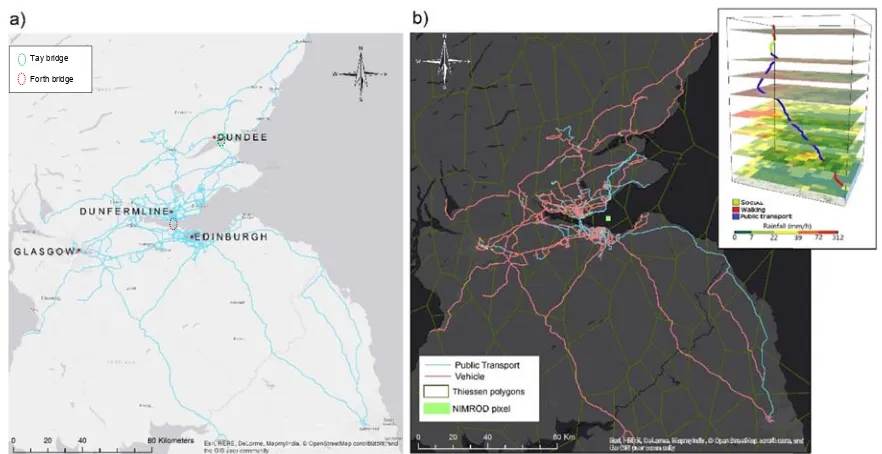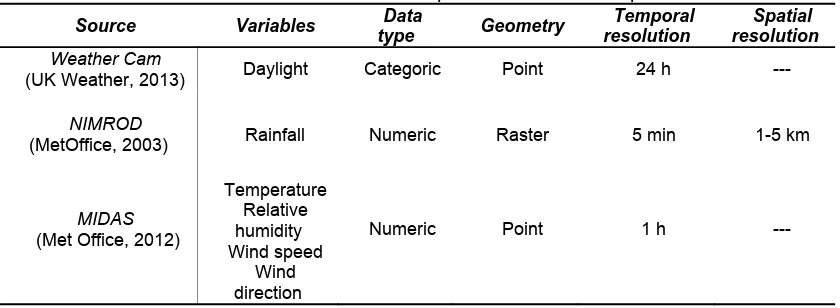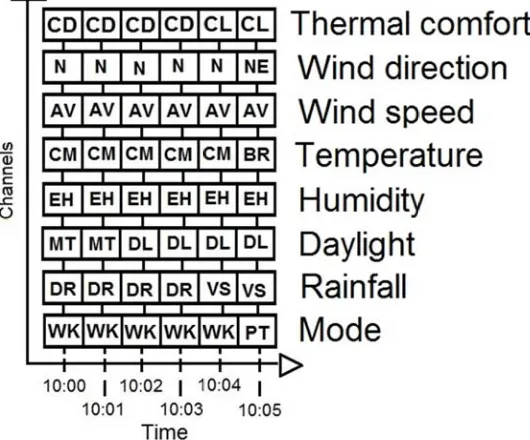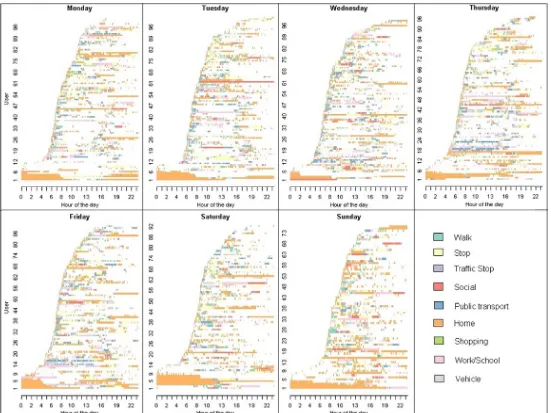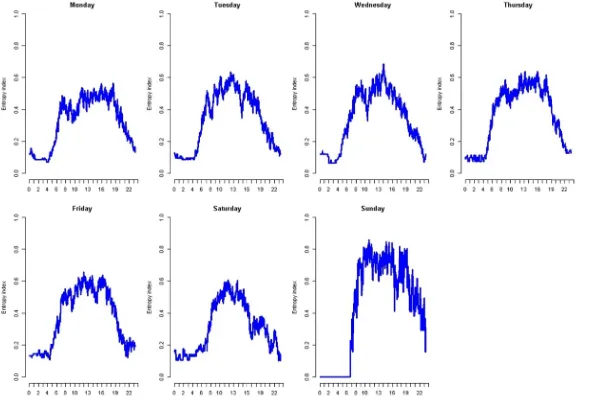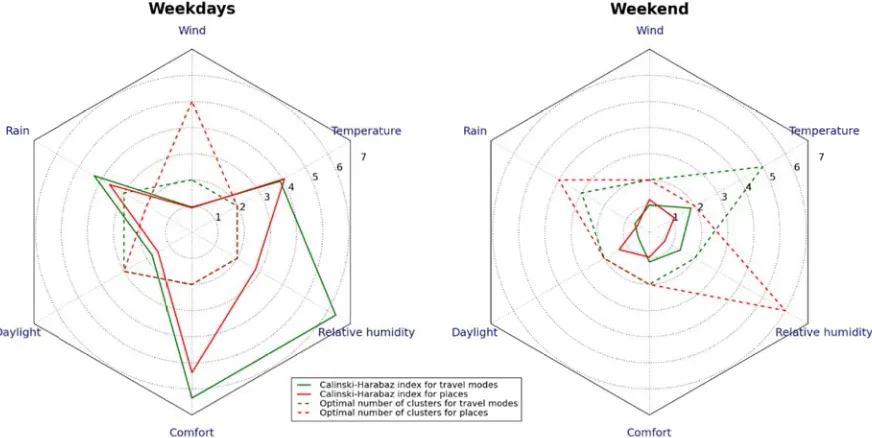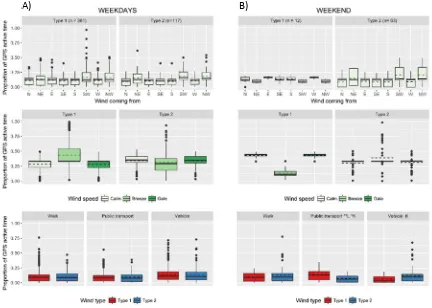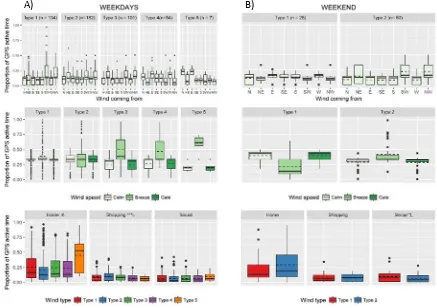WEATHER EFFECTS ON HUMAN MOBILITY: AN ANALYSIS USING MULTI-CHANNEL
SEQUENCE ANALYSIS
Vanessa S. Brum-Bastos
1, Jed A. Long
1, Urška Demšar
11
School of Geography & Sustainable Development, University of St Andrews,
Irvine Building, North Street, St Andrews, UK
5
Email: {vdsbb*, jed.long, urska.demsar}@st-andrews.ac.uk
*Corresponding author
Abstract
Widespread availability of geospatial data on movement and context presents opportunities for
10
applying new methods to investigate the interactions between humans and weather conditions.
Understanding the influence of weather on human behaviour is of interest for diverse applications,
such as urban planning and traffic engineering. The effect of weather on movement behaviour can be
explored through Context-Aware Movement Analysis (CAMA), which integrates movement geometry
with its context. More specifically, we use multi-channel sequence analysis (MCSA) to represent a
15
person’s movement as a multi-dimensional sequence of states, describing either the type of
movement or the state of the environment throughout time. Similar movement patterns can then be
identified by comparing and aligning mobility sequences. In this paper we apply CAMA and MCSA to
explore weather effects on human movement patterns. Data from a GPS tracking study in a Scottish
town of Dunfermline are linked to weather data and converted into multi-channel sequences which are
20
clustered into groups of similar behaviours under specific weather typologies. Our findings show that
the CAMA + MCSA method can successfully identify the response of commuters to variations in
environmental conditions. We also discuss our findings on how travel modes and time spent at
different places are affected by meteorological conditions, mainly wind, but also rainfall, daylight
duration, temperature, comfort and relative humidity.
25
Keywords:
context-aware movement analysis, context-aware similarity, human mobility, human
movement, multi-channel sequence analysis, context.
1. Introduction
The spread of geolocated smartphones and the decreasing price of GPS devices have contributed
towards the production of large amounts of data on human movement of unprecedented
spatio-30
temporal quality (Meekan et al., 2017). New human mobility studies attempt to link such movement
data with contextual information (such as points of interest) to gather insights into, for example,
commuting behaviour (Beecham, Wood, & Bowerman, 2014; Gong, Chen, Bialostozky, & Lawson,
2012), tourist behaviour (Meijles, de Bakker, Groote, & Barske, 2014; Versichele, Neutens,
Delafontaine, & Van de Weghe, 2012), or retail choice decisions and human activities (Si
ł
a-Nowicka
35
Manuscript accepted to
Computers, Environment and Urban Systems
, May 2018
tourism (de Freitas, 2003), health (Tucker & Gilliland, 2007), psychology (Nerlich & Jaspal, 2014) and
40
epidemiology (Horowitz, 2002).
Specific weather conditions often trigger changes in human behaviour, for example, higher
temperatures increase aggressiveness (Anderson, 2001; Carlsmith & Anderson, 1979) and lower
temperatures contribute to irritability and combativeness (Schneider, Lesko, & Garret, 1980; Worfolk,
1997). Different components of weather have different magnitudes of importance, for example, air
45
temperature, direct solar radiation and wind speed have a more significant influence on human
behaviour than humidity (de Montigny, Ling, & Zacharias, 2012). However, it is challenging to
understand how weather influences human behaviour because the responses are partially a result of
individual preferences (de Freitas, 2015). Some individuals are more responsive to the thermal
component of weather, i.e. the combined effects of air temperature, humidity and solar radiation, while
50
some are more receptive to physical components like rain, and others are more greatly affected by
the aesthetic components, such as cloud coverage and sunshine. Yet, most individuals do respond to
the combination of all three of these components (de Freitas, 1990).
Traditionally, these interactions have been explored through questionnaires and multidimensional
scaling methods within the field of human biometeorology (Cabanac, 1971; de Freitas, 1990; Manu,
55
Shukla, Rawal, Thomas, & de Dear, 2016). With the increased availability of tracking and
environmental data we however propose that the effect of weather on movement behaviour can be
explored through Context-Aware Movement Analysis (CAMA), which integrates movement geometry
with its context, i.e. with the surrounding biological and environmental conditions that might be
affecting movement (Andrienko, Andrienko, & Heurich, 2011; Demsar et al., 2015; Dodge et al.,
60
2013). More specifically we use multi-channel sequence analysis (MCSA) to represent a person’s
movement as a sequence of states, describing either the type of movement or the state of the
environment throughout time. Similar movement patterns can then be identified (termed context
aware similarity analysis) by comparing and aligning mobility sequences.
Similarity analysis is one of the most common tasks in movement analytics and consists of using
65
geometry or physical attributes; geometrical similarity solely relies on measures of spatial and
70
temporal distances, and physical similarity relies on movement attributes such as speed, turning
angle, acceleration and direction (Demsar et al., 2015). Context-aware similarity is based on multiple
attributes (Andrienko et al., 2011; Buchin, Dodge, & Speckmann, 2014; Demsar et al., 2015; Sharif &
Alesheikh, 2017b) describing the conditions within which the movement took place.
Context-awareness is a recent trend (Sharif & Alesheikh, 2017a), as a result there are few
context-75
aware methods for assessing similarity between trajectories. Sharif & Alesheikh (2017b) generalized
the dynamic time warping (DTW) to develop a context-based dynamic time warping (CDTW) method,
which matches trajectories with contextual similarity even if they are not concurrent. This method is
highly dependent on arbitrary weights for the contextual variables, restricted to numeric context and
disregards changes of context between two points in time. i.e., same contexts are considered similar
80
even when they are not concurrent. De Groeve et al. (2016) uses single channel sequence
alignments and Hamming Distance to understand the temporal variation of habitat use by roe deer;
the similarity is measured by the cost to transform a sequence of habitat use into another. This
method is able to handle only one contextual variable at time, therefore it is not able to handle the
interactive effect of multiple contextual variables on movement. Buchin et al. (2014) modified existing
85
similarity measures to make them context-aware, more specifically they defined the distance between
two points as the sum of their contextual and spatial distances. The transition costs between contexts
are defined by the user and the method is restricted to contextual data in the form of polygonal
divisions.
In this paper we propose to use multi-channel sequence analysis (MCSA) to perform context-aware
90
similarity analysis (CASA) and cluster trajectories into groups of similar behaviour. MCSA is a new
analysis tool for movement data where contextual information can now be readily combined with
detailed tracking datasets. The main advantage of this approach is that it also is possible to consider
as many channels (contextual variables) as desired at once. It is common in movement research to
simultaneously consider multiple environmental variables, which makes MCSA particularly relevant for
95
Manuscript accepted to
Computers, Environment and Urban Systems
, May 2018
Israel (Shoval & Isaacson, 2007) and to analyse sequential habitat use by roe deer in North-East Italy
100
(De Groeve et al., 2016). Shoval & Isaacson (2007) focused on sequences of locations, i.e. the
movement itself, while De Groeve et al (2016) emphasized sequences of habitat use classes, i.e. the
context surrounding movement. Horanont
et al.
(2013) looked at GPS traces from mobile phone users,
coarse scale movement data, hourly temperature, rainfall and wind speed to explore the independent
effects of each variable on people’s activity patterns. We innovate by applying MCSA, for the very first
105
time, to perform CAMA of fine scale human movement data to simultaneously consider movement
and context by looking at the combined and single effects of six meteorological variables.
Despite the novelty of MCSA in movement research, sequence analysis has been consistently used
in medical and social sciences, particularly within bioinformatics and life courses research (Idury &
Waterman, 1995) Abbott 1995; Abbott & Tsay 2000). In bioinformatics, a sequence represents the
110
DNA molecule as a string of characters (which stand for specific nucleotides), between a precise start
and end point; the comparison of similarities and differences between those strings allows the
identification of nucleotide sequences related to genetic diseases and traits. We propose that the
same principle can be applied to movement trajectories for identifying groups of people with similar
movement patterns, i.e., clusters of similar behaviour (Billari, 2001). Further, we propose to not only
115
represent the trajectories with one sequence only, but to use Multi-channel sequence analysis
(MCSA), which allows for comparison of sequences consisting of several dimensions (channels)
(Gauthier
et al.
, 2010). For this, we link data from a GPS tracking study to weather data and convert
the information into multi-channel sequences in a first fully data-driven attempt to explore weather
effects on human movement patterns.
120
The rest of the paper is structured as follows: first we describe the GPS tracking data and weather
datasets used in our analysis. Next, we explain how the meteorological data sources were combined
and integrated with the GPS tracking data and finally converted into sequences. Next, multi-channel
sequence analysis is applied to identify changes in group movement patterns related to weather. We
conclude with considerations on our findings, the potential of the methodology and ideas for future
125
research.
130
135
To stud
1). In St
points to
those tra
variable
to calcu
channel
algorithm
showing
statistica
dy the influe
tep 1, we inte
o weather v
ajectories in
, travel mode
ulate a dissim
sequences
m to partition
g similar mo
al test to valid
Step 1
Step 2
Step 3
Step 4
Step 5
ence of weath
egrate trajec
variables, wh
to multi-cha
e and places
milarity matr
in our datas
n the sequen
ovement beh
date and und
her on huma
ctories with c
hich resulted
nnel sequen
s. In Step 3, w
rix describing
set. In Step 4
nces into sim
haviour unde
derstand diff
an mobility be
contextual da
d in contextu
nces by crea
we use optim
g the degre
4, we use W
milarity base
er particular
ferences betw
ehaviour we
ata by using
ualized trajec
ating alphabe
mal matching
ee of differen
Ward’s cluster
ed groups, w
weather co
ween groups
used a
five-trajectory an
ctories. In S
ets with cod
g distances (A
nce between
ring (Murtag
which represe
nditions. In
s.
-step proces
nnotation to
Step 2, we t
des for each
Abbott & Tsa
n each pair
h & Legendr
ent groups o
Step 5, we
Manuscript accepted to
Computers, Environment and Urban Systems
, May 2018
Figure 1 – The overview of our framework for identification of groups of similar movement behaviour
140
under specific weather conditions. The framework has two analyses running in parallel: analysis of
places and analysis of travel modes. Blue shapes marks travel mode, green shapes marks places,
white ellipses represent dataset’s sources, rectangles represent variables, beige arrows represent
processing steps and hexagons derived results in each step.
145
Trajectory annotation and sequencing were performed using PostgreSQL 9.4 database manager,
VANJU library and its dependencies under Python 2.7, for more details refer to Brum-Bastos, Long,
& Demšar (2016). The MCSA, including optimal matching distances, Ward’s clustering and statistical
tests, was performed using TraMineR 1.8-9 and cluster 1.14.4 libraries under R 3.4.1, for more details
on the equations used by these libraries please refer to Gabadinho, Ritschard, Studer, & Müller (2009)
150
and Maechler, Rousseeuw, Struyf, Hubert, & Hornik, (2018) respectively.
2.1. Movement
data
We analysed a human movement dataset where GPS devices were carried by volunteers from the
Kingdom of Fife – UK (Figure 2a) (Si
ł
a-Nowicka et al., 2016). The data were collected between the
155
28
thof September 2013 and the 10
thof January 2014 as part of the GEOCROWD project (Si
ł
a-Nowicka et al., 2016), in which 6000 individuals were randomly selected by postcode address from
the voting registry (focusing on the three major towns in this region) and invited via letter to participate
in the study. In total, 206 individuals accepted the invitation and provided useable data whereby they
were tracked for two consecutive weeks within the study time spam. GPS devices recorded
160
participant positions every five seconds, representing a very high-resolution trajectory of participant
locations. The GPS trackers were coupled with accelerometers, which turned off the GPS when the
individual was not moving Oshan
et al.
2014). The aim of the GEOCROWD project was to develop
new movement analytics methods that would allow researchers to find out as much as possible from
the actual GPS data while participants were asked to do as little as possible (i.e. the only task was to
165
carry a GPS device and mail it back after two weeks). Therefore, very little auxiliary data were
collected and beyond gender and age of the participants, which were sourced from the electoral
register together with the address of each participant, no other demographic or ground truth data were
collected. For more details on data collection refer to Oshan
et al.
(2014).
In this paper we re-analyse the GEOCROWD data from the town (called Dunfermline; Figure 2a)
170
175
180
185
190
195
46 were
their age
about pa
Figure
represen
Forth ro
polygons
of a NIM
corner il
cube wit
The pa
Traffic S
Stop) (S
compari
classifica
et al.
20
2.2.
We lin
linear dy
contextu
immedia
Tay Fore between 35
e. As stated
articipants or
2 – a) Ea
nted by light
oad bridges r
s used to int
MROD (Met O
llustrates a t
th rainfall dat
articipant tra
Stop, Bus St
Si
ł
a-Nowicka
ng a 200 m
ation algorith
16).
Contextual
ked meteoro
ynamic trajec
ual variable
ately before
y bridge rth bridge5 and 60 yea
above, apa
r their activiti
ast coast of
blue lines. T
respectively.
terpolate MID
Office's nowc
trajectory sam
ta for a
one-ajectories we
top, Train St
et al., 2016)
range from
hm (for more
data and co
ological data
ctory annota
at the time
and after the
ars old, 8 we
art from their
es were ava
f Scotland w
The green an
b) Sample
DAS (Met Of
casting syste
mple classifi
hour period.
ere classified
top, Fig. 2b)
). The classi
the recorde
e details on d
ontext integ
from ground
tion (DTA-L)
e when the
e point chro
ere between
r home addr
ailable for our
where the
nd the red e
of two move
ffice Integrat
em) product
ied into mov
d into movem
) and stop c
ification achi
ed home add
data segmen
ration
d stations an
) (Brum-Bast
GPS point
onologically.
61 and 65 y
ess, gender
r secondary
GPS data w
llipses repre
ement travel
ted Data Arc
for comparis
vement mode
ment classes
lasses (Hom
eved 85% a
dresses with
ntation and c
nd orbital sat
tos et al., 20
was collec
The DTA-L
years old, an
, and age; n
data analysis
were collect
sent the loca
modes over
chive System
son. The fram
es and displa
s (Walk, Tra
me, Work, Sh
ccuracy, wh
the home lo
lassification
ellites to mo
016), a metho
cted by inte
method acco
nd 27 did no
no further inf
s.
ted, and tra
ations of the
rlaid by the T
m) data and o
me in the rig
ayed in a sp
ain, Bus and
hopping, Un
ich was asse
ocation foun
refer to
Sila-ovement data
od that estim
erpolating the
ounts for the
ot declare
formation
ajectories
Tay and
Thiessen
one pixel
ght upper
pace-time
Vehicle
,identified
essed by
nd by the
-Nowicka
a through
mates the
rate-of-Manuscript accepted to
Computers, Environment and Urban Systems
, May 2018
change between contextual layers, producing more realistic values for interpolated meteorological
data, and it also deals with the difference between temporal resolutions of the datasets (Brum-Bastos
et al. 2017). We collated multiple sources of contextual data on weather (Table 1).
[image:8.595.89.509.186.340.2]200
Table 1– Contextual datasets with respective sources and specifications.
Source Variables Data
type Geometry
Temporal resolution
Spatial resolution Weather Cam
(UK Weather, 2013) Daylight Categoric Point 24 h ---
NIMROD
(MetOffice, 2003) Rainfall Numeric Raster 5 min 1-5 km
MIDAS (Met Office, 2012)
Temperature Relative humidity Wind speed
Wind direction
Numeric Point 1 h ---
We associated MIDAS data with trajectory points using Thiessen Polygons around each
meteorological station (n = 109, Fig 2b). From the MIDAS meteorological variables we also derived
the apparent temperature (
, which considers the combined effects of temperature, humidity and
205
wind (Steadman, 1994).
0.33 ∗
0.70 ∗
4.00
(1)
Here
is the air temperature in °C; is the water vapour pressure in hPa calculated from the
relative humidity and temperature; and
is the wind speed in m/s.
The Weather Cam data was used to calculate dusk, sunset, sunrise and dawn times (for a central
210
location in the study area) as at this latitude daylight length varies by approximately 4.5 hours from
September to January. Daylight categories were annotated to trajectories according to the following
rules: Morning Twilight (MT) for fixes recorded in the period between dawn and sunrise, Day Light (DL)
for fixes recorded between sunrise and sunset, Evening Twilight (ET) for fixes recorded between
sunset and dusk, Night (NI) for fixes recorded between dusk and dawn.
215
2.3. Trajectory
sequencing
Tsay, 2000). However, most phenomena are multidimensional and require multiple alphabets. This
means that each dimension gets its own bespoke alphabet and instead of having the data object
represented as one sequence, the object now has as many different sequences as there are
dimensions, which are called channels (therefore the name Multi-Channel Sequence Analysis). The
alignment, i.e. similarity, then needs to be calculated across all channels along the time axis (Gauthier
225
et al., 2010). This multi-channel approach is therefore a shift from looking at individual units towards
analysing context, connections and events (Abbott, 1995).
We created several bespoke alphabets, one for movement mode (e.g., walking and driving) and one
for each weather variable in our data. For this, we had to translate the GPS track of each participant
into a multi-channel sequence consisting of time units, to which the characters were assigned (figure
230
3). Weather conditions were categorized to create weather-based alphabets (Table 2). Rainfall was
classified based on the UK Met Office scale for rainfall intensity, Wind Speed according to an
adaptation of the Beaufort scale (Royal Meteorological Society, 2017), wind direction according to the
cardinal and collateral points, apparent temperature according to the VDI (2008) thermal perception
scale, humidity and temperature according to the 1991-2000 seasonal climate normals for
235
Dunfermline from Jenkins
et al.
(2009). Climate normals are a three-decade average of weather
variable commonly used to characterize local climates (Ayoade, 1986).
The multi-channel sequences were then generated for each volunteer and day (illustrated in Figure
3) by taking the modal weather condition (for each variable described in Table 2) and movement
mode for each 1-minute interval for each participant. To each time unit we assigned descriptors for
240
the weather variables and the respective movement mode, which are linked to the descriptor for the
following time unit building multiple chronologically arranged strips. These sequences can be
analysed alongside strips of contextual variables to understand not only the responses to specific
variables, but also to different combinations of those variables and the identification of patterns
relative for specific age groups, gender or other profiling information. The number of channels in a
245
250
255
[image:10.595.167.432.79.299.2]260
Figure
to one o
We calc
minute (
group of
of places
indicates
while an
average
and on
amount
participa
this, we
Manuscrip
3 - A multi-c
of the meteor
culated the e
(Billari, 2001
f sequences
s and travel
s an even d
n EI closer to
e time expend
each day of
of time spen
ant, keeping
calculated th
pt accepted t
channel sequ
rological varia
entropy index
). The EI is a
(Gabadinho
modes acro
distribution o
o zero indica
diture at hom
f the week. T
nt in each m
in mind that
he mean for
to
Computer
uence for a p
ables and m
x (EI) for the
a measure o
o et al., 2009
ss the week
of a contextu
ates a high le
me, socialisin
The average
movement m
each state
the gender o
rs, Environme
participant ov
ovement mo
e movement
of the comple
9),which in ou
and hours o
ual variable
evel of assoc
ng, shopping
e time expen
mode and div
in our seque
of participant
ent and Urba
ver a five-min
odes for that
t mode chan
exity induced
ur case can
of the day. In
across mov
ciation with o
, walk, public
nditure was c
viding it by th
ences corres
ts (male, fem
an Systems
, M
nute period,
minute of the
nnel for all se
d by the distr
be used to
our analysis
vement mode
one mode. W
c transport a
calculated b
he total GPS
ponded to o
male).
May 2018
each channe
e day.
equences of
ribution of st
observe the
s, an EI clos
es (alphabet
We also look
and vehicle b
by first comp
S active time
one minute. F
el relates
Table 2 – Alphabets for meteorological variables used as contextual data with respective ranges and description. Letters in each alphabet are defined based
265
on standard meteorological classifications (see text for more details).
Thermal perception (°C) Rainfall (mm/h) Wind coming from direction (°)
Letter Description Range Letter Description Range Letter Description Range
VC Very Cold <= -39 DR Dry 0 N North > 337.5 - 22.5
CD Cold >-39 - -26 VS Very Slight >0 - 0.5 NE North East >22.5 -67.5
CL Cool >-26 - -13 SL Slight >0.5 – 1 E East > 67.5 -112.5
SC Slightly Cool >-13 - 0 LM Low Moderate >1 – 2 SE South East >112.5 - 157.5
CF Comfortable >0 - 20 MO Moderate >2 – 4 S South >157.5 – 202.5
SW Slightly Warm >20 - 26 HV Heavy >4– 10 SW South West >202.5 – 247.5
W Warm >26 – 32 VH Very Heavy >10 - 50 W West 292.5 > 247.5 –
H Hot >32 – 38 VI Violent > 50 NW North West >292.5 – 337.5
VH Very Hot >38
Humidity (%) Temperature (°C) Wind Speed (m/s)
Letter Description Range Letter Description Range Letter Description Range
EH Extremely High >90 EL Extremely Low <=5 CM Calm <= 3
AA Above Average >85 -90 AN Average minimum > 5-7 BR Breeze >3 - 14
AV Average >80 -85 AV Average Average >7 -10 GA Gale >14 - 24
BA Below Average >75 -80 AX Average Maximum >10 - 13 ST Storm >24
LW Low >70 -75 EH Extremely High >13
